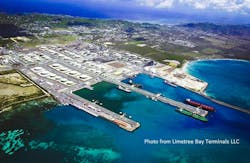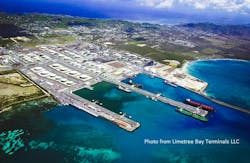US Virgin Islands, ArcLight float plan to restart St. Croix refining complex
Senators of the 32nd Legislature of the US Virgin Islands will hold a special session next month to evaluate a proposed $1.4-billion operating agreement between the government and ArcLight Capital Partners LLC, Boston, that could lead to the restart of the previously idled 500,000-b/d refinery at Limetree Bay, on the island of St. Croix (OGJ Online, Jan. 18, 2012).
Called by USVI Gov. Kenneth Mapp to a special session scheduled to begin on July 25 in Charlotte Amalie, St. Thomas, legislators will consider legislation incorporating two new agreements relating to the operation of the oil refinery and related installations at the site that, together, could lead to the refinery’s restart in about 18 months, according to Gov. Mapp’s office.
Alongside reopening the refinery, the plan, if approved, would create hundreds of jobs in the Territory and inject hundreds of millions of dollars into the local economy, generating new tax revenues as well as shore up solvency of the Government Employees Retirement System (GERS), Mapp said.
Under the agreement, ArcLight—owner of Limetree Bay Terminals LLC (LB Terminals), which in 2016 restarted terminal assets connected to the former Hovensa LLC-owned refinery at Limetree Bay—would invest more than $1 billion between now and 2020 to rehabilitate, restart, and operate the refinery, creating about 1,400 jobs during the construction phase and 700 full-time jobs once the refinery restarts.
Upon closing of the proposed transaction, newly created ArcLight subsidiary Limetree Bay Refining would pay the government $70 million, and upon restart of the refinery, annual payments in lieu of taxes of $22.5 million, with an adjustment based on the refinery’s performance that could raise the annual payment to as much as $70 million but never below $14 million in normal circumstances.
If the refinery performs as the government’s industry experts at Gaffney, Cline & Associates have projected, the government would receive more than $600 million during the first 10 years after restart vs. the $330 million Hovensa—a joint venture of Hess Corp. and Petroleos de Venezuela SA—paid the government in corporate income taxes in the more than 30 years it operated the refinery, according to Mapp.
The $600 million in payments would be in addition to the income generated by LB Terminals’ oil storage terminal, which will continue to make payments currently amounting to about $11 million annually as promised under the original terminal operating agreement (OGJ Online, Jan. 8, 2016; Jan. 4, 2016).
To date, LB Terminals has invested about $260 million in capital improvements to the terminal operations and presently is in the final stages of building a single-point mooring buoy that will allow the terminal to handle the world’s largest tankers, Mapp added.
New refinery operating agreement
Alongside minor amendments to the existing terminal operating agreement, the new deal establishes a refinery operating agreement, under which LB Terminals will transfer its ownership of the refinery to LB Refining, which in turn will enter into a separate operating agreement with the government as well as assume independent financial and other obligations, according to government documents.
Under the refinery operating agreement, LB Refining will:
• Pay the government $70 million at closing, consisting of $30 million to purchase government-owned lands surrounding the refinery and another $40 million in prepayments of future taxes.
• Pay the government annual payments of $22.5 million, adjusted based on refinery's performance to a maximum of $70 million and a minimum of $14 million in most circumstances.
• Pay the government a 10% commission if the refinery is sold at a profit, with a minimum payment of $12.75 million (one-half the original $25.5 million minimum payment, with the other half coming upon a sale of the terminal).
• If the refinery fails to restart, or if the refinery restarts and then shuts down permanently, decommission and deconstruct the facility at its own expense.
Regarding issues of employment for USVI residents—more than 2,000 of whom became jobless following Hovena's 2012 closure of the refinery and one of the most recurrent hurdle facing the original 2016 terminal operating agreement—the new refinery operating agreement requires LB Refining to aggressively advertise open positions, to give preference to qualified local residents over nonresidents, and to use commercially reasonable efforts to ensure that at least 80% of workers are USVI residents.
Qualified residents of St. Thomas and St. John interested in working during reconstruction of the refinery also will be offered a place to live while working on St. Croix without charge, according to the governor.
Schedule
The parties intend that the amended terminal operating agreement and new refinery operating agreement will close simultaneously subject to execution of both agreements by the parties, the legislature's approval of the two agreements, and finalization by LB Refining of certain unidentified contracts with long-term supply and offtake contracts.
Ideally, the new deal would result in the refinery’s restart by yearend 2019 with an initial crude processing capacity of about 200,000 b/d, Gov. Mapp’s office said.
“The objective of the overall strategy is to have refined product from the St. Croix refinery in the market come January 2020,” the governor said.
The deal also would help fund a new 110-room upscale hotel on St. Thomas—its first new hotel development in more than 38 years—as well as provide an infusion of cash to help resuscitate GERS, which is currently scheduled to run out of money in 2024.
Combined, the amended terminal operating and new refinery operating agreements could bring an estimated $775 million in revenues to the government during the next 10 years, of which more than $600 million would be generated entirely by the refinery, the governor’s office said.
Given ArcLight’s plan to commit a massive capital investment in a compressed time period to capture market opportunity in the oil industry, timing is of the essence in completing the turnaround and restart of the refinery, according to Gov. Mapp.
“This landmark deal to jumpstart our recovery and to pave the road to better times requires us to move expeditiously if the refinery is to restart on schedule,” Mapp said, noting the 2-year process of complex negotiations required to reach the deal via collaboration between his administration, ArcLight, US President Trump’s administration, the US Environmental Protection Agency, the US Department of Justice, and other unidentified major players in the global oil industry.
“More work remains to be done, but this agreement allows the Virgin Islands to accelerate its recovery, grow its economy, create jobs for its people, propel new startup businesses, as well as support existing businesses, and ultimately provide revenues for our government and our retirement system,” Mapp added.
ArcLight will detail its strategy and schedule for construction activities during the special legislative session.
In 2016, the government gauged idled refinery units at the St. Croix complex with a combined peak-processing capacity of about 650,000 b/d.
Contact Robert Brelsford at [email protected].

